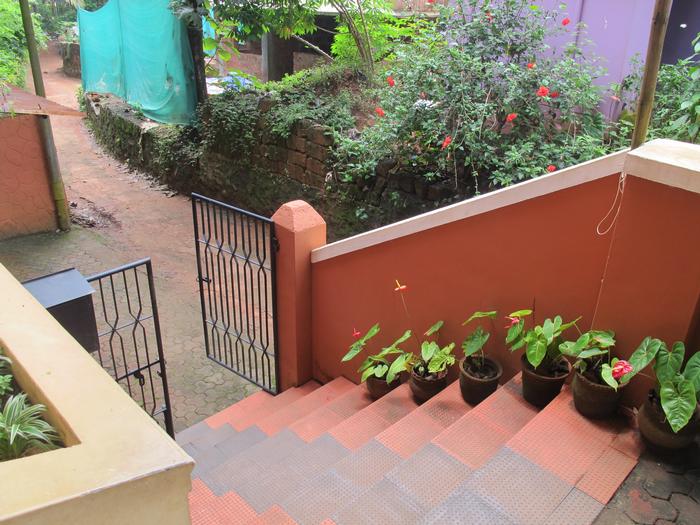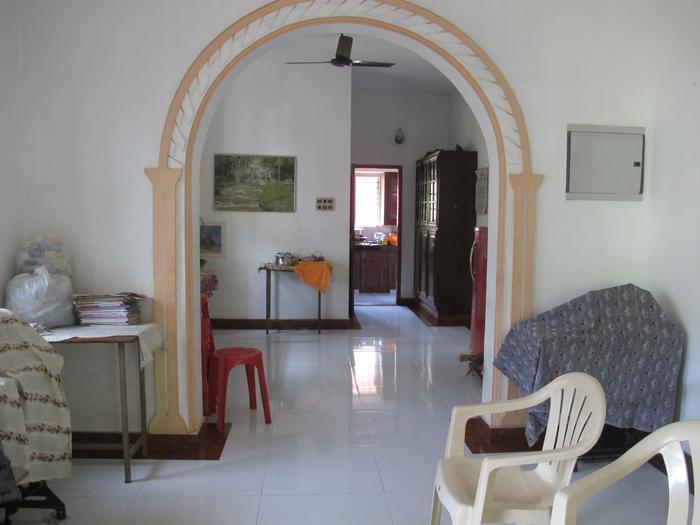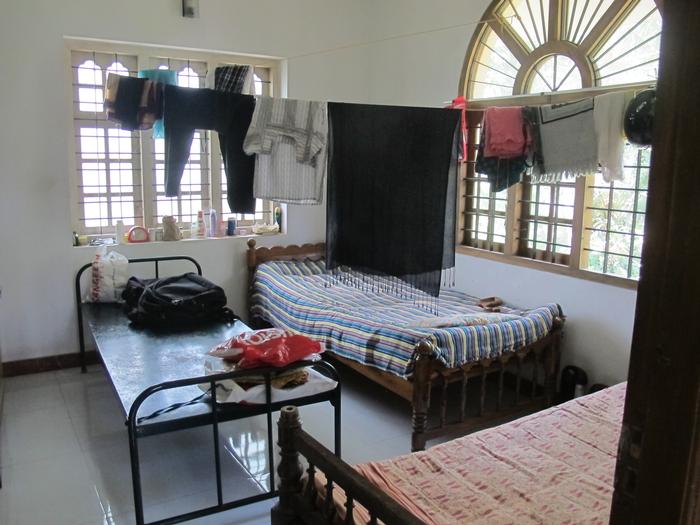Meghna Mohandas EssayVermilion of hopeConfronting poverty – the first thing that comes to your mind is eradicating poverty by direct means. There is a famous saying – Give a man a fish, and you feed him for a day; show him how to catch fish, and you feed him for a lifetime. A huge world of darkness that has been created by poverty at the grass root level and to confront poverty, we need to look at the bigger picture. While deciphering the brief, the first question that came to my mind was- How do I define poverty? Literally, it means the lack of a certain amount of wealth or possession. The direct effects are what we can see – less access to proper houses, food or sanitation. But the indirect effects of poverty are many. One of these many problems is that poor households tend to invest in the education of their sons, than their daughters, as India still lives by the concept that daughters are to be married off into another household one day, and once they are married, they depend upon the husband to earn for the family. Women face the sharp end of a predominantly patriarchal society, and they remain unaware of their right to education. And so, they are not considered important in the development of society. The pre-conceived notion that women are weaker than men results in domestic violence in most marriages; the greed for dowry and alcoholism being the major catalysts. What we need is a space where these women can get help, a transitional space that can help them take control of their lives, so that they can educate their daughters, and take a step towards eradicating poverty. An article I read recently stated that 70% of women in India have faced some sort of domestic violence, including marital rape, in their lives. In such a situation, the victims are scared to raise their voice because they have to face the wrath of a conservative society, and in most cases, their own parents become unsupportive. Moreover, they don’t know how to earn a living for themselves, because of the lack of education and trained skills. During my study about women who have faced abuses, I came across a rehabilitation home for destitute women in my hometown Kozhikode, in the Indian state of Kerala. Kozhikode is a Muslim dominated city, and most girls here are married off at a young age, having completed only their high school education. The society is strict, and most girls are restricted to the four walls of their home, and not many are allowed to go out of their homes without being accompanied by a male relative. For most of these girls, their husband is the first male they interact with who is not a relative. When these girls face trouble in their marriage, they don’t know how to react or who to call for help. And the fact that society looks down on women who are divorced or separated from their husbands does not help. A place where these women can find shelter, safety and help is the need of the hour, but not too many of them exist, nor does society understand the concept of destitute homes. Fighting all odds against the conservative society, Anweshi short stay home for destitute women was founded by Mrs.Ajitha in 1993. A former naxalite, she was actively involved in the naxal protests in north Kerala during the 1960’s, which ultimately led her to 8 years in jail. Being a woman activist, she faced a lot of torture during her time in jail. This made her understand and learn more about the problems faced by women in the country, especially sex workers. She was also inspired by the verdict of the famous Mathura rape case, in which a teenage tribal girl was raped by two policemen in a police station, and the court acquitted the accused, on the basis that the victim was “habituated to having intercourse”. This case went on to change the rape laws in the country. K.Ajitha realized that there was no voice for women in the country, and decided to be one herself. Currently, the team at Anweshi includes four counselors, three lawyers, and other social workers who are in charge of the administration. The purpose of a short stay home is to provide a temporary place for destitute women to stay. During this period, the counselors and lawyers try to understand the situation of the woman, and act in the required manner. They file court cases, or invite the husband to talk out the issue. They also teach the inmates basic skills like gardening and stitching, which can help them create a source of livelihood for themselves. Instead of providing them with a permanent home, they sort out the problems, and teach them how to create a home for themselves. The idea was that these women have been dependent on another person all their lives, and they need to learn how to be self- dependent, and to bring up their children on their own. The major problem in the running of this home is the lack of funds. The concept of a rehabilitation home is not widely accepted in society, and unfortunately, the government has also not yet recognized the need of such homes. When the idea of this home was being realized, Mrs. Ajitha wanted a courtyard in the center of the building, separate rooms for different activities, and play areas and study rooms for the children of the affected. But unfortunately, the only people who were ready to provide funds were the well-off Non Residential Indian’s, and that too, only a few of them. The current home is being run on the first floor of the house of a widowed school teacher, which has been taken on rent by Anweshi. The external staircase to the upper floor has been decorated with potted plants, which is the work of some of the inmates. Stepping into the house, I walk into the large multi functional space which acts as the living room, the TV room, and there are also sewing machines kept on one side. This is where most activities occur, and the inmates have tried to add a bit of color to the otherwise dull room, with plastic flowers. One of the walls is also decorated by three pictures that a 6 year old daughter of one of the inmates had drawn. There are three bedrooms, and currently seven inmates, two of them with children. They share the bedroom spaces, and there are attached bathrooms in each one of these bedrooms. A tiny kitchen is placed at the corner of the living room, and the cooking is done by the caretaker of the short stay home, who is also part of Anweshi. The inmates spend most of the day either watching TV, or learning to stitch. The only open space in the home is a balcony that faces a field with a lot of trees and greenery. This balcony is where they spend the evenings, drinking tea, and talking amidst themselves. The openness helps these women to open up to each other, which does not happen much if they are sitting in the living room watching TV, said Ajitha. The counselors explain that many of the women who come there are mentally traumatized. Ideally, they need more open spaces to grow in. The environment needs to be the right balance of built and open space, as too much of either could be intimidating. They support the original idea that Mrs. Ajitha had in mind – the central courtyard with bedrooms surrounding it. This space could create interaction between the inmates, and can also be used for gardening and playing. A courtyard could make them feel like they are in an open space, but they still feel safe as they are surrounded by built mass. Multiple occupancies (two people in a room) are preferred over single room occupancies, as these women need to talk to people, and some inmates may even have suicidal tendencies. Also, children are encouraged to interact with their disturbed mothers, as it may help in the healing process. Different workshops need to be created to teach the inmates different skills, both technical and otherwise. Improving their language and building up their self confidence can improve the much required soft skills for creating a livelihood for themselves. For this, an Open Air Theater (OAT) can be included in the landscape, where seminars can be conducted, and programs can be organized by the inmates. Most of the women are accompanied by their children, hence it is important to provide playgrounds and creches for these children to play and grow. Study rooms can also be provided as many of the children are of the school going age. The dreams and hopes of many are being realized in the form of the new rehabilitation home being built by the same team. They hope to fulfill the psychological and materialistic requirements of the inmates, but funds are a major issue. The new home is being designed by Ar. Sandhya, who started her own architectural practice in Kozhikode in 2005, after she separated from her husband, having faced domestic violence. She tells me that her parents understood the need for education, and hence, she could earn a living for herself after the divorce, but she took up this project for those women who were not lucky enough. Being a woman herself, she understands the types of spaces required. For example, the private areas (bedrooms and bathrooms) should be well buffered from the public and semi-public spaces that are open to visitors and staff, and the windows of the bedrooms should overlook private open spaces. But she also explains that not all is possible with the limited area and budget. During the design process, she visited the inmates to understand what kind of spaces they would like in the home. Not too many people voiced opinions, but from what she gathered, she decided to incorporate a lot of colorful spaces, along with the suggestions that were put forward by the counselors. When Sandhya asked the inmates for their suggestions, the inmates explained to her that they are grateful to Anweshi for providing them with help and shelter when they had no one and no place to go to, and they felt that voicing opinions about the design would portray the feeling that they were not satisfied with what they have been provided with. The important thing in the design was that it should relate to the human scale, and should not be a tall building. The plot size is only 320 square meters, and a lot has to be done in it. Currently, the project is in the design development stage. Instead of bedrooms, dormitories are being provided, each with a capacity of 10 people and attached bathrooms. This increases the chances of interaction between inmates, and works well with the budget too. The front desk area/lobby opens up into a central courtyard,which is surrounded by a living room, a kitchen, two office spaces for administration and a room for sewing machines and other equipment,which are also being squeezed into the budget. Sandhya tells me that the rooms should be cheerful and colorful, to improve the spirit of the traumatized women, and also because most women are accompanied by children, and children should not be living in spaces that are dull, as it could adversely affect the growth process. A question that came to my mind was – how different would the design be had the architect been a person of the opposite sex? To which, Sandhya tells me that the biggest obstacle he would have had to face would have been trying to get the inmates to talk to him. If the reason they are there is because they have been traumatized by a man, they would be not comfortable opening up to a male architect. The counselors tell me that there is a reason that all the staff at Anweshi are women; it is because the inmates feel more comfortable around them. But in the process of self improvement, the counselors want men to be involved at a later stage because to face the world on their own these inmates need to be confident talking to all people. Ajitha says that she is currently looking for funds so that a small OAT (Open Air Theater) can also be included in the design for the new home. If this can be done, then people from all walks of life can be invited to give motivational and inspirational speeches, and also conduct workshops with the inmates. People from both genders can be invited, and this can also be an opportunity for the inmates to interact with people from the opposite gender. The reason why Ajitha does not want to hold such sessions within an enclosed space is that not all women would be comfortable being in the same room as a man, after the trauma they have been through, whereas this would not be an issue in an OAT. Such sessions could also help in promoting the idea of a rehabilitation home in the society. If people started volunteering to conduct sessions, then slowly the world would realize the need for such homes, and start accepting the concept. As an architect, I appreciate the effort taken by the team to create something within the given constraints. The only thing I felt was missing from the design they have in mind was a library that could be accessed by the inmates at any time. The library could have books of different inspiring authors, in various languages. Apart from the much required motivation, the books could also help improve the communication skills of the inmates. Tables facing the window in the library could make reading more enjoyable, and books could become topics of discussions. The purpose of a short stay home is to elevate women of the nation to a level where they are strong and self confident, because empowering women is one way to uprooting poverty. When you educate a woman, you educate her family. If more people started contributing both time and money to this cause, a chain of short stay homes could be started across the country, and maybe later on, throughout the world. It is a continuous process, and in this process, the architecture of the surrounding space plays a major role in the development of personalities. Additional Help and InformationAre you in need of assistance? Please email info@berkeleyprize.org. |
|




